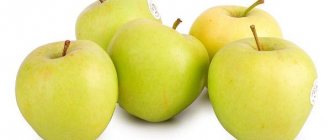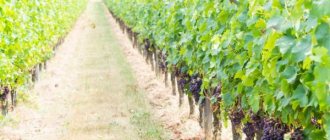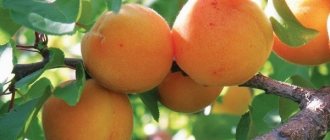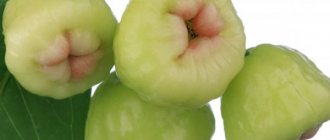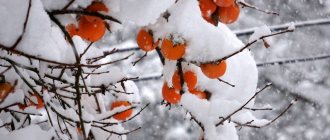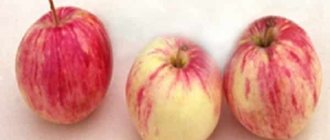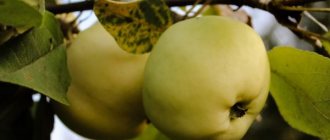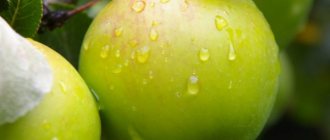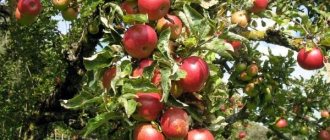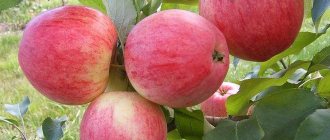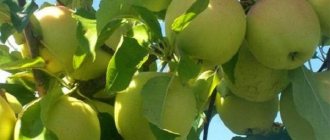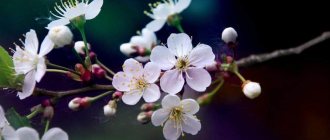Gardening » Apple tree
0
537
Article rating
Kira Stoletova
The Russian apple tree is the result of crossing two popular varieties - Babushkino and Antonovka. The hybrid combines their positive qualities: it is frost-resistant and has immunity to various garden diseases. The apple tree grows quickly and produces a stable harvest. The culture is taking root in the central regions of the country.
Varietal features of the Russian apple tree
Description, photo
The Russian apple tree is considered a late winter variety. This variety was developed by Isaev S.I.
The Russian woman was obtained by crossing the Babushkino and Antonovka Obyknovennaya varieties. These two varieties belong to folk selection and have very good winter hardiness. Therefore, Russian also has a high level of winter hardiness.
In addition, it is also resistant to scab , which is an advantage of the apple tree.
After planting, the first fruiting begins in 5–6 years. Apple tree productivity is high.
The tree is medium in size and has a round, densely leafy crown.
The apples are medium in size. The maximum weight of the fetus is up to 140 grams. The average fruit weight varies from 110 to 120 grams:
- The shape of apples is round or round-conical. Their surface is smooth. The fruits have no integumentary color. The main color of apples is golden yellow. This color is characteristic mainly of ripe fruits;
- The funnel of apples has a slightly orange tint. The variety received this funnel color from Antonovka Obyknovennaya;
- The pulp is white. It has a sweet and sour taste. The fruits are superior in sugar and ascorbic acid content to the fruits of Antonovka Ordinary. On average, their content reaches 35 mg;
- The fruits do not ripen on the tree. Therefore, they must be removed in advance. After picking, the fruits ripen after one month. If stored properly, apples can be stored until March-April.
Fruits of the Russian apple tree.
Apple tree Rossiyanka description and characteristics of the variety, history of selection and yield
Description of the variety
Many farmers prefer old varieties, which have gained enormous popularity in industry and on private plots. Such trees are perfectly acclimatized and have been successfully grown for decades from the southern regions to the north of Siberia. They combine excellent taste and above-average yield, increased winter hardiness and many other advantages that, as a rule, new trees do not yet have. Let's look at the most popular ones.
- Antonovka. She can be called a leader in the race for championship. Every gardener in Russia, Ukraine, Moldova, Belarus and all neighboring countries knows it. For more than 40 years, it has remained the best option for industrial use, since it is impossible to improve the classic, beloved variety. It yields up to 120 kg from an adult tree, up to 75 kg from a 7-year-old seedling. The pulp is sweet, there is a slight sourness, overall decent taste... Growing Antonovka is simple and profitable. Some fruits can reach 460 g if there are few of them on the crown. With a significant load on the tree, their weight becomes no more than 150 g.
- Alyonushka. Another native Russian version of a high-yielding tree. The fruits have an excellent appearance, a little reddish, with a brown tint, they are extremely dense, transportable, and are stored until the month of May. The plant can withstand temperatures down to -46 degrees and is recommended for cultivation in many northern regions. From one tree you can take 85 kg of ripe fruits with good presentation; they have all the advantages of columnar fruits. 95% of products are stored until mid-winter if stored correctly. The apple tree is resistant to many diseases and can withstand drought.
- Sun. The apples were obtained as a result of the work of the Krasnodar breeding site in 1992. They still remain one of the best fruits in terms of their taste, transportability, and appearance. The tree can grow in the southern regions, as well as in the colder northern and central regions, it can withstand temperatures down to -45 degrees Celsius, and long-term droughts. The plant is unpretentious to growing conditions: one treatment with complex insecticides and autumn pruning is enough to get a good harvest of fruit. In the fifth year, the seedling produces up to 45 kg of fruit, which is why many gardeners chose to work with Solnyshka for the purpose of subsequent sale and found the business extremely profitable.
The varieties described above are the most stable and high-yielding; they have remained the best for decades and are popular in many countries. They are highly resistant to cold, pests, droughts and other troubles, and even in the most “difficult” years they produce an average harvest.
This variety of apple tree was obtained by crossing the Anis Polosatyy and Pepin Shafranny varieties by breeder Sergei Ivanovich Isaev.
When starting to describe an apple tree, it is best to start with the fact that the ripe fruits of this species are quite large. On average, their weight reaches about 200 grams.
The apples are round-conical in shape, with a smooth cream-colored skin and red stripes. However, due to the fact that the variety is still late-winter, the apple should sit for a month and a half to gain flavor and juiciness.
Vityaz is a vigorous, stocky tree resembling a small oak. As a rule, the tree has large and powerful branches that allow it to withstand a rich harvest. The crown is dense. The leaves are large, dark green in color. It is precisely from these features that it is clear that it is difficult to grow an apple tree in a small garden or near a house.
When the tree is in bloom, the flowers are collected in light pink “bouquets” of 5 pieces. The tree blooms in late spring. When planting it, you should pay attention to the fact that the pollination of the variety is arranged in such a way that the pollen independently falls on the pistil.
Apples of the Vityaz variety are classified as winter apples, since the fruits of the apple tree begin to ripen only at the end of September-October.
Pros and cons of the variety
Like every variety, Vityaz has advantages and disadvantages.
The unconditional positive factors include:
- A large amount of fruit. As a rule, gardeners collect up to 250 kilograms from one tree.
- Large fruit sizes.
- The juiciness and sweetness of every apple.
- Frost resistance.
- Storing fruit all winter and even spring.
- Apples are healthy fruits recommended for consumption by medicine to improve health.
The fruits of the Vityaz apple tree can be used on the farm:
- for juice production;
- dried fruit preparations;
- when canning;
- when baking.
The disadvantages of the apple tree include several factors:
- Requires care in winter.
- Large spreading crown.
This species has much fewer disadvantages, so the developed variety is excellent for growing in any conditions and regions of the country. Moreover, the trees themselves are unpretentious in care, which also does not leave many gardeners indifferent.
Amateur gardeners talk only about the positive characteristics of this species. The fruits from such a tree are collected quickly, and the apple tree itself does not require much or careful care. The lack of need for special care and a lot of advantages make Vityaz apples interesting for farmers who grow fruit for sale.
additional characteristics
Advantages and disadvantages
The most important advantages of the apple tree are good winter hardiness and high disease resistance:
- The tree can easily survive particularly harsh winter conditions;
- Copes well with nighttime temperature changes both in winter and spring;
- Has resistance to diseases such as scab;
- High yield;
- Long period of storage of fruits;
- Apples are high in ascorbic acid.
The variety has no particular disadvantages. The only thing that can be emphasized is that you cannot eat such fruits in the summer.
Sizes of an adult tree and annual growth
The tree is medium in size. Its average height reaches from 4 to 4.5 meters. Sometimes it can grow 5 meters.
With proper shaping and pruning, you can form a compact tree, the height of which will be approximately 3 - 3.5 meters.
A medium-sized tree should usually have a growth of at least 60 centimeters . Otherwise, the apple tree experienced discomfort. It could be a disease or a massive pest attack. In this case, the increase will be less than 60 centimeters.
Also, the increase can be 70 -75 centimeters. But too much growth is not a good indicator. Since long branches may not have time to ripen well and prepare for wintering. Then in winter the shoots may freeze.
Branches that have grown too much may freeze in winter.
Important! The reason for too much growth may be excessive feeding of the tree with nitrogen fertilizers. Thus, it is nitrogen fertilizers that help develop and increase the above-ground mass of plants. Therefore, you need to be careful in this matter.
Productivity and frequency of fruiting
The Russian woman's productivity is at a high level. After the apple tree begins to bear fruit, it bears fruit every year. Although the maternal form of Antonovka Ordinary does not show such a tendency.
Tasting assessment
Apples are quite tasty and are in demand among people. But the tasting score often does not exceed 4.5 points.
Winter hardiness
Since the maternal forms had fairly high winter hardiness, the Russian woman also has this ability. Winter hardiness of the Russian woman is one of the main advantages of the variety.
Disease resistance
The apple tree has a high level of immunity . The tree is resistant to scab. When choosing a variety, this is an important indicator.
Apple scab.
Advantages and disadvantages
The variety tolerates low temperatures
The variety stands out for its winter hardiness. Sudden changes in temperature or long winters are not scary for the crop. Such high rates are determined not only by the characteristics of the variety itself, but also by proper care. If the tree is not insulated for the winter, it may suffer.
High immunity is another advantage of the variety. If trees in the garden begin to get sick, then in most cases this species will remain unharmed.
High yield is also one of the advantages of the variety. The number of apples increases every year. They are densely located on the branches: the shoots can sag under load, but rarely break. This is another advantage of the variety.
Fruits are stored for a long period and do not spoil. The advantages of the variety include good transportability. Apples are sold and remain attractive to buyers for a long time.
The variety has few disadvantages. Delicious apples can be eaten raw, but only after they have stood. Immediately after harvest they are very sour and inedible. The fruits are used to make juices and jams: but even in this case, you will have to wait until the harvest reaches the desired state.
Reviews
Anastasia. “I like the Russian woman because of her many advantages. These include good winter hardiness, scab resistance, and high yield. I also like the taste of the fruit. It is also important that apples are very healthy. Children also love these apples. We mainly consume the fruits fresh. They keep for a long time. If the temperature is maintained, it can be stored until April. I recommend everyone to plant this variety at home. Eating such fruits in winter is not only very tasty, but also healthy.”
Valery. “The variety is very good for growing in many regions of the country. The apple tree is quite unpretentious. It winters well, as it has a high level of winter hardiness. The fruits are very tasty, healthy and have a long shelf life.”
Svetlana. “Russian is a very good variety. Very popular among other varieties. The tree has all the positive characteristics. The apple tree produces a bountiful harvest every year. The fruits are juicy and tasty. Contain a lot of sugar and ascorbic acid. Apples can also be stored for a long time. If proper conditions are met, the fruits can last until April.”
Features of planting and care
Landing
Deadlines
in spring
The optimal time for planting apple trees is spring - the last ten days of April and the beginning of May . At this moment, the seedlings have not yet woken up from hibernation.
It is during this period that planting should be done. Then the apple tree will take root well and will immediately begin to develop well.
in autumn
Planting can also be done in the autumn. But here you need to be careful with the timing. The best time is considered to be mid to late September.
A seedling planted in the fall must have time to form a root system and grow shoots. The branches must have time to ripen before the onset of cold weather. Otherwise, the seedling may freeze.
Scheme
For medium-sized apple trees, the planting pattern will be 4.5 by 3.5 or 4 by 3 meters.
This arrangement will allow you not to interfere with neighboring apple trees.
Distance between trees when planting.
Technology
To avoid mistakes when planting seedlings, you should follow a certain algorithm:
- It is necessary to dig a planting hole. Its depth will depend on the size of the seedling's root system. On average, the depth of the planting hole varies from 70 to 80 centimeters;
- You need to dig a steel stake into the middle of the hole. To which the seedling is subsequently fixed;
- A small hill is made from the soil, on which the root system of the seedling is straightened;
- Water is poured into the hole and covered with soil. Thus, a soil chatter is obtained;
- The planting hole is completely filled with soil and then watered abundantly;
- After the soil has settled, you need to add more soil and water again.
Attention! It is important not to cover the root collar of the apple tree. It should be at ground level. If it is exposed, the apple tree may freeze, which can reduce the tree’s immunity. Accordingly, the apple tree can then be damaged by pests and diseases.
Agricultural technology and cultivation
Apple tree agricultural technology consists of:
- Timely watering;
- Feeding;
- Protection from diseases and pests;
- Pruning and crown formation.
to water at least three to four times per season In this case, watering should be plentiful. The soil should be saturated with moisture to a depth of about 10 centimeters. You need to water at a distance of 60 centimeters from the tree trunk along the entire circumference.
At the same distance, fertilize the apple tree . You can use both organic and mineral fertilizers. Complex mineral fertilizers are most often used. In their composition, all components are in the required ratio. From organic fertilizers you can use compost and ash.
Types of fertilizers.
If the tree does not have disease resistance or it is weak, then preventive measures must be taken . You can also use pesticides and preparations based on natural ingredients. Special traps are used against pests.
Pruning and crown formation
Sanitary pruning is necessary annually. It helps the tree to be in a constantly renewed state. When sanitary pruning, it is necessary to remove old and diseased branches. Often the branches grow inside the crown, thereby thickening the crown.
Advice! If you always carry out sanitary pruning, the apple tree will be well ventilated and will not waste energy on restoring and healing old tissues.
Formative pruning is carried out as desired. Some people like a large and spreading tree, while others like it neat and compact. Most often they form a sparsely tiered crown. This crown has the required number of branches. The crown is well ventilated, and the tree does not experience an overload of fruits.
Pollination
The apple tree can pollinate itself, but when pollinated by insects, the yield, fruit size and taste are noticeably improved.
Also, the yield will be increased if there are other varieties in the garden plot.
Features of ripening and fruiting
Fruiting
Start
After planting, the Russian apple tree variety begins to bear fruit in 5–6 years.
After the tree begins to bear fruit, the apple tree produces a harvest every year.
Peculiarities
The Russian woman has one peculiarity of fruiting. The tree has a late ripening period, so it is recommended to pick apples so that the fruits ripen at home.
Approximate fruit harvesting is recommended at the end of September and beginning of October. After a month, the apples should be ripe.
Russian apples ripen after picking.
Deadlines
Blooms
The apple tree is a late winter variety. Therefore, flowering is also slightly delayed compared to other apple trees. Flowering usually begins in early to mid-June. In early spring, flowering can begin at the end of May.
Fruit ripening
The Russian apple tree variety is a very late apple tree and the apples ripen around October. Ripening times may vary depending on weather conditions.
Harvest storage
A feature and also an advantage of the Russian woman is the long shelf life of the fruit.
If all temperature rules are observed, as well as maintaining optimal air humidity, fruits can be stored from autumn to March and April.
Growing in regions
In Siberia
The climatic conditions of Siberia are characterized by severe frosts. But Rossiyanka has almost excellent winter hardiness.
In the conditions of Siberia, the Russian woman feels good. Sometimes there may be slight freezing in a mild form.
Important! But since the apple tree has a strong immune system, it painlessly and quickly restores or replaces the affected tissue.
In the Leningrad region
In the conditions of the Leningrad region, the tree also feels good, even despite strong winds. High winter hardiness and good stability make themselves felt.
In outskirts of Moscow
As in other regions of the country, the Russian woman is taking root well here too . It is good to tolerate winter and spring temperature changes. This is a very good variety for growing apple trees in these regions.
Video Review
The Russian apple tree is the result of crossing two popular varieties - Babushkino and Antonovka. The hybrid combines their positive qualities: it is frost-resistant and has immunity to various garden diseases. The apple tree grows quickly and produces a stable harvest. The culture is taking root in the central regions of the country.
Varietal features of the Russian apple tree
